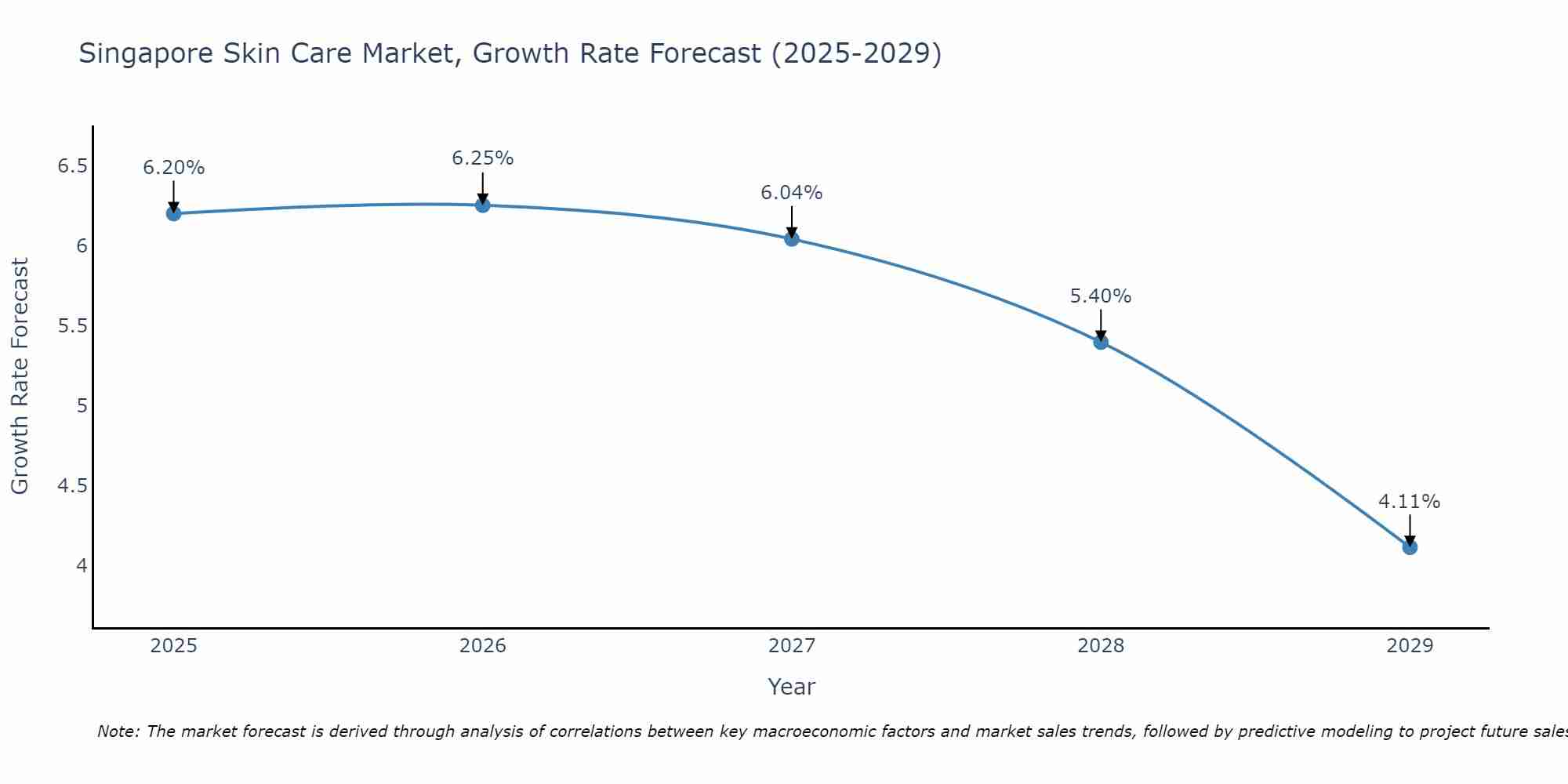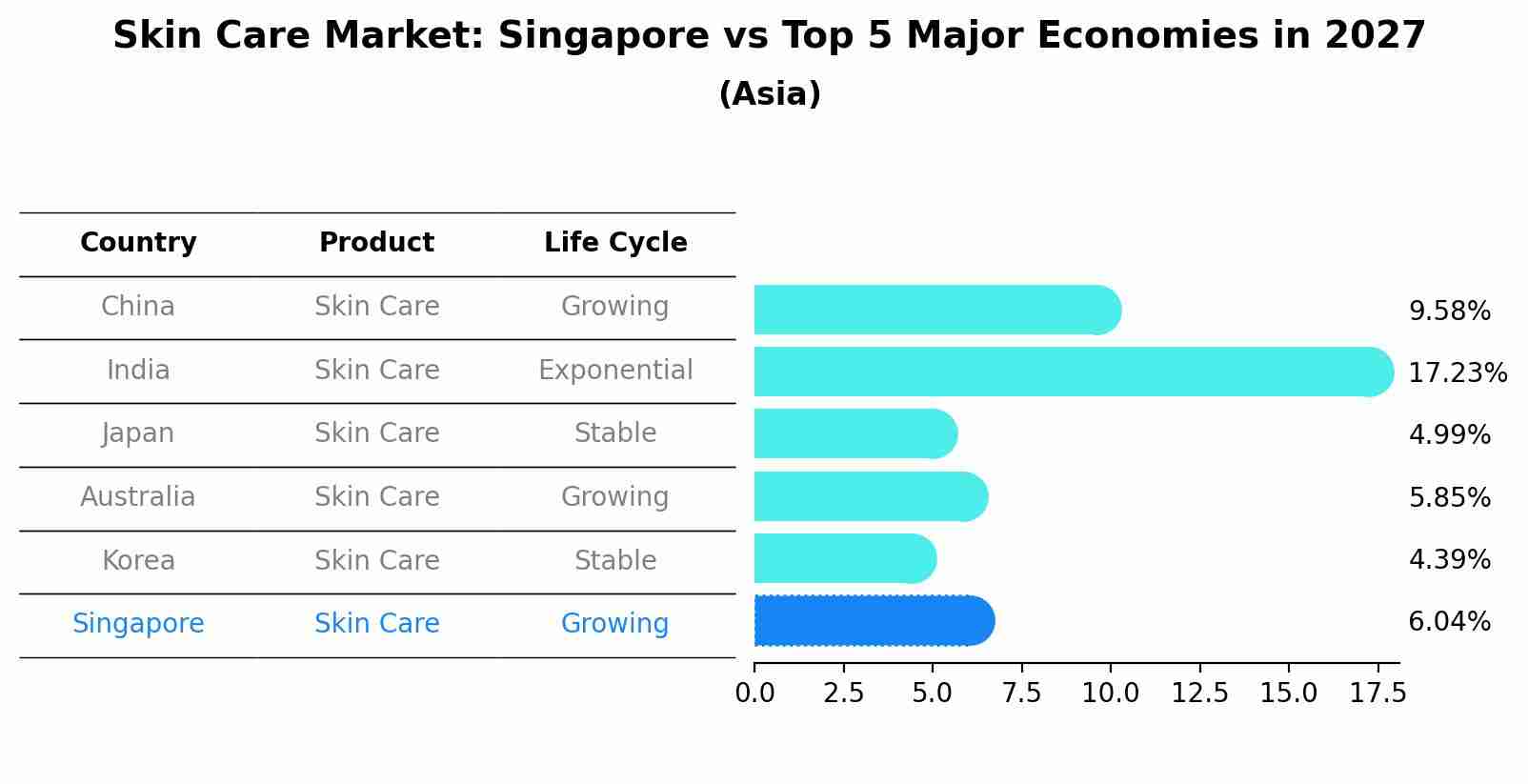Singapore Skin Care Market (2024-2030) | Trends, Outlook, Industry, Revenue, Growth, Share, Size, Forecast, Companies, Value, Analysis
| Product Code: ETC010427 | Publication Date: Jul 2023 | Updated Date: Apr 2025 | Product Type: Report | |
| Publisher: 6Wresearch | Author: Ravi Bhandari | No. of Pages: 70 | No. of Figures: 35 | No. of Tables: 5 |
Singapore Skin Care Market Size Growth Rate
The Singapore Skin Care Market is projected to witness mixed growth rate patterns during 2025 to 2029. Growth accelerates to 6.25% in 2026, following an initial rate of 6.20%, before easing to 4.11% at the end of the period.

Skin Care Market: Singapore vs Top 5 Major Economies in 2027 (Asia)
Singapore's Skin Care market is anticipated to experience a growing growth rate of 6.04% by 2027, reflecting trends observed in the largest economy China, followed by India, Japan, Australia and South Korea.

Singapore Skin Care Market Synopsis
The Singapore skin care market is projected to reach a CAGR of 5.7% during the forecast period (2020-2026). The rising awareness regarding personal hygiene, increasing disposable income among the middle class households and growing demand for organic products are some of the factors driving the growth in this market. This market is further being augmented by various product launches with improved packaging along with affordable pricing strategies adopted by manufacturers catering to different segments such as age group, gender ETC
Market Drivers
Increasing Awareness Regarding Personal Hygiene : Consumers are now more aware about their skincare needs due to increased media exposure and online information sharing that has led them towards paying better attention on their skin care regimen. This has resulted in an increase in demand for quality products from both local and international players leading to higher sales revenues for this sector.Rising Disposable Income Levels Among Middle Class Families : The rise in income level among middle class families have enabled them to buy expensive branded products which were earlier unaffordable. This trend is expected to drive revenue growth over the coming years as consumers look for natural or organic ingredients based products rather than cosmetic ones which may be potentially harmful for their skin health over time.Growing Demand For Organic Products : There has been a surge in popularity of organic/natural based beauty and personal grooming items recently mainly due to rising awareness amongst consumers about potential side effects associated with using chemical laden cosmetics/skin care products.As a result, there exists a huge opportunity within this segment which is likely capitalize upon by industry players offering herbal alternatives at competitive prices.
Market challenges
High Cost Of Raw Materials : With raw material costs accounting up to 80% of total production cost, it becomes difficult for manufactures especially smaller ones who fail compete against larger companies having economies scale resulting into reduced profitability margins affecting overall business outlooks.Stringent Government Regulations And Policies : Regulatory policies implemented by government bodies tend change frequently putting extra burden manufacturing processes related testing procedures thereby increasing lead times between product launch cycles adversely impacting supply chain operations.Moreover shifting consumer preferences requires considerable amount adaptation terms technology process optimization making whole exercise quite complicated one hampering long term sustainability plans.
Key players
The key players operating in the Singapore skin care market are Unilever, Johnson & Johnson Consumer Inc., Est?e Lauder Companies, Shiseido Co. Ltd., L???Or?al Group, Beiersdorf AG, and Procter & Gamble Company. These companies have been involved in product innovation and launching of new products to meet consumer demands for natural ingredients and organic labels. The strategic acquisitions made by these companies are expected to drive the growth of this market over the coming years.
Covid-19 Impact
Due to Covid - 19 pandemic, it led numerous consumers towards online shopping channels because most offline stores were closed completely or had limited operations leading towards digital sales channel being preferred choice among buyers globally.This trend was seen even within skin care industry where many brands started selling their products through ecommerce portals making it easier & convenient option for customers who prefer buying without having much hassle involved throughout process.Additionally, manufacturers shifted focus onto developing home based remedies using items present easily around households instead of opting out for expensive treatments available commercially thereby impacting negatively upon revenues earned from traditional stores around country too owing same cause mentioned above i.e lockdown restrictions imposed due measurement controlling spread virus across regions worldwide.
Key Highlights of the Report:
- Singapore Skin Care Market Outlook
- Market Size of Singapore Skin Care Market, 2023
- Forecast of Singapore Skin Care Market, 2030
- Historical Data and Forecast of Singapore Skin Care Revenues & Volume for the Period 2020-2030
- Singapore Skin Care Market Trend Evolution
- Singapore Skin Care Market Drivers and Challenges
- Singapore Skin Care Price Trends
- Singapore Skin Care Porter's Five Forces
- Singapore Skin Care Industry Life Cycle
- Historical Data and Forecast of Singapore Skin Care Market Revenues & Volume By Product Types for the Period 2020-2030
- Historical Data and Forecast of Singapore Skin Care Market Revenues & Volume By Face Creams for the Period 2020-2030
- Historical Data and Forecast of Singapore Skin Care Market Revenues & Volume By Body Lotions for the Period 2020-2030
- Historical Data and Forecast of Singapore Skin Care Market Revenues & Volume By Distribution Channel for the Period 2020-2030
- Historical Data and Forecast of Singapore Skin Care Market Revenues & Volume By Online for the Period 2020-2030
- Historical Data and Forecast of Singapore Skin Care Market Revenues & Volume By Offline for the Period 2020-2030
- Singapore Skin Care Import Export Trade Statistics
- Market Opportunity Assessment By Product Types
- Market Opportunity Assessment By Distribution Channel
- Singapore Skin Care Top Companies Market Share
- Singapore Skin Care Competitive Benchmarking By Technical and Operational Parameters
- Singapore Skin Care Company Profiles
- Singapore Skin Care Key Strategic Recommendations
Frequently Asked Questions About the Market Study (FAQs):
1 Executive Summary |
2 Introduction |
2.1 Key Highlights of the Report |
2.2 Report Description |
2.3 Market Scope & Segmentation |
2.4 Research Methodology |
2.5 Assumptions |
3 Singapore Skin Care Market Overview |
3.1 Singapore Country Macro Economic Indicators |
3.2 Singapore Skin Care Market Revenues & Volume, 2020 & 2030F |
3.3 Singapore Skin Care Market - Industry Life Cycle |
3.4 Singapore Skin Care Market - Porter's Five Forces |
3.5 Singapore Skin Care Market Revenues & Volume Share, By Product Types, 2020 & 2030F |
3.6 Singapore Skin Care Market Revenues & Volume Share, By Distribution Channel, 2020 & 2030F |
4 Singapore Skin Care Market Dynamics |
4.1 Impact Analysis |
4.2 Market Drivers |
4.3 Market Restraints |
5 Singapore Skin Care Market Trends |
6 Singapore Skin Care Market, By Types |
6.1 Singapore Skin Care Market, By Product Types |
6.1.1 Overview and Analysis |
6.1.2 Singapore Skin Care Market Revenues & Volume, By Product Types, 2020-2030F |
6.1.3 Singapore Skin Care Market Revenues & Volume, By Face Creams, 2020-2030F |
6.1.4 Singapore Skin Care Market Revenues & Volume, By Body Lotions, 2020-2030F |
6.2 Singapore Skin Care Market, By Distribution Channel |
6.2.1 Overview and Analysis |
6.2.2 Singapore Skin Care Market Revenues & Volume, By Online, 2020-2030F |
6.2.3 Singapore Skin Care Market Revenues & Volume, By Offline, 2020-2030F |
7 Singapore Skin Care Market Import-Export Trade Statistics |
7.1 Singapore Skin Care Market Export to Major Countries |
7.2 Singapore Skin Care Market Imports from Major Countries |
8 Singapore Skin Care Market Key Performance Indicators |
9 Singapore Skin Care Market - Opportunity Assessment |
9.1 Singapore Skin Care Market Opportunity Assessment, By Product Types, 2020 & 2030F |
9.2 Singapore Skin Care Market Opportunity Assessment, By Distribution Channel, 2020 & 2030F |
10 Singapore Skin Care Market - Competitive Landscape |
10.1 Singapore Skin Care Market Revenue Share, By Companies, 2023 |
10.2 Singapore Skin Care Market Competitive Benchmarking, By Operating and Technical Parameters |
11 Company Profiles |
12 Recommendations |
13 Disclaimer |
- Single User License$ 1,995
- Department License$ 2,400
- Site License$ 3,120
- Global License$ 3,795
Search
Thought Leadership and Analyst Meet
Our Clients
Related Reports
- Germany Breakfast Food Market (2026-2032) | Industry, Share, Growth, Size, Companies, Value, Analysis, Revenue, Trends, Forecast & Outlook
- Australia Briquette Market (2025-2031) | Growth, Size, Revenue, Forecast, Analysis, Trends, Value, Share, Industry & Companies
- Vietnam System Integrator Market (2025-2031) | Size, Companies, Analysis, Industry, Value, Forecast, Growth, Trends, Revenue & Share
- ASEAN and Thailand Brain Health Supplements Market (2025-2031) | Strategy, Consumer Insights, Analysis, Investment Trends, Opportunities, Growth, Size, Share, Industry, Revenue, Segments, Value, Segmentation, Supply, Forecast, Restraints, Outlook, Competition, Drivers, Trends, Demand, Pricing Analysis, Competitive, Strategic Insights, Companies, Challenges
- ASEAN Bearings Market (2025-2031) | Strategy, Consumer Insights, Analysis, Investment Trends, Opportunities, Growth, Size, Share, Industry, Revenue, Segments, Value, Segmentation, Supply, Forecast, Restraints, Outlook, Competition, Drivers, Trends, Demand, Pricing Analysis, Competitive, Strategic Insights, Companies, Challenges
- Europe Flooring Market (2025-2031) | Outlook, Share, Industry, Trends, Forecast, Companies, Revenue, Size, Analysis, Growth & Value
- Saudi Arabia Manlift Market (2025-2031) | Outlook, Size, Growth, Trends, Companies, Industry, Revenue, Value, Share, Forecast & Analysis
- Uganda Excavator, Crane, and Wheel Loaders Market (2025-2031) | Strategy, Consumer Insights, Analysis, Investment Trends, Opportunities, Growth, Size, Share, Industry, Revenue, Segments, Value, Segmentation, Supply, Forecast, Restraints, Outlook, Competition, Drivers, Trends, Demand, Pricing Analysis, Competitive, Strategic Insights, Companies, Challenges
- Rwanda Excavator, Crane, and Wheel Loaders Market (2025-2031) | Strategy, Consumer Insights, Analysis, Investment Trends, Opportunities, Growth, Size, Share, Industry, Revenue, Segments, Value, Segmentation, Supply, Forecast, Restraints, Outlook, Competition, Drivers, Trends, Demand, Pricing Analysis, Competitive, Strategic Insights, Companies, Challenges
- Kenya Excavator, Crane, and Wheel Loaders Market (2025-2031) | Strategy, Consumer Insights, Analysis, Investment Trends, Opportunities, Growth, Size, Share, Industry, Revenue, Segments, Value, Segmentation, Supply, Forecast, Restraints, Outlook, Competition, Drivers, Trends, Demand, Pricing Analysis, Competitive, Strategic Insights, Companies, Challenges
Industry Events and Analyst Meet
Whitepaper
- Middle East & Africa Commercial Security Market Click here to view more.
- Middle East & Africa Fire Safety Systems & Equipment Market Click here to view more.
- GCC Drone Market Click here to view more.
- Middle East Lighting Fixture Market Click here to view more.
- GCC Physical & Perimeter Security Market Click here to view more.
6WResearch In News
- Doha a strategic location for EV manufacturing hub: IPA Qatar
- Demand for luxury TVs surging in the GCC, says Samsung
- Empowering Growth: The Thriving Journey of Bangladesh’s Cable Industry
- Demand for luxury TVs surging in the GCC, says Samsung
- Video call with a traditional healer? Once unthinkable, it’s now common in South Africa
- Intelligent Buildings To Smooth GCC’s Path To Net Zero


















